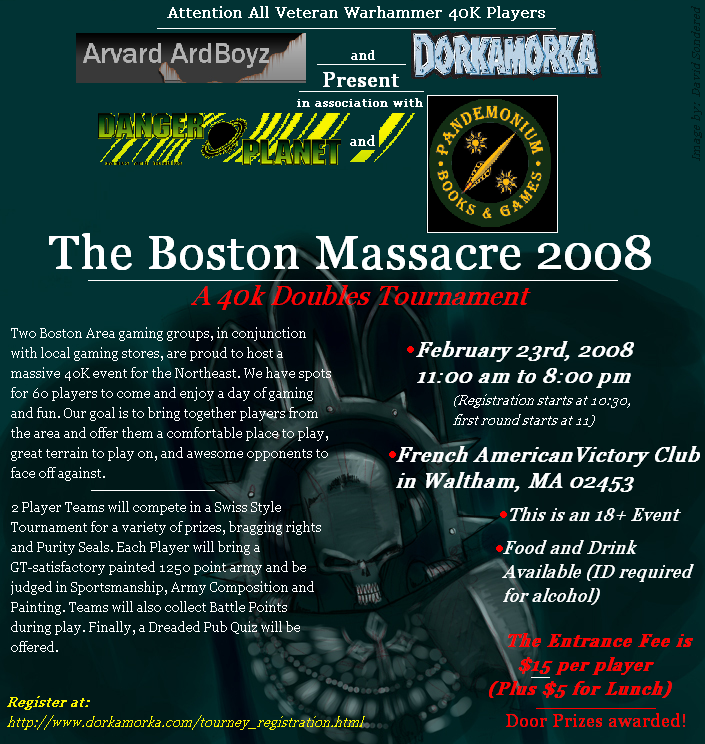skip to main |
skip to sidebar
Some of you Tau players might have seen a conversion done by Tael (from Eastern Empire and Advanced Tau Tactica). It's a stealth Crisis Battlesuit and decided to basically copy the suit. Here's basically a step by step guide to creating a model like this for yourself.
Components:
Stealth suit (new)(only a single model)
Crisis Suit
Landraider Sponson 'cover'
Lascannon Tips
Spacemarine Jump pack
Greenstuff
A few blocks of regular, good, old, scrap plastic
OK, putting the knife to a brand new suit takes a bit of nerve, but remember even a green stuff noob (like me) can fix small problems. I'm going to use one of my first crisis suits as a little display model (don't mind the sloppy paint job).
One of the easiest pieces to convert is the Jet Pack. To do so cut the middle torso piece (the piece between the thrusters and chest plate) and cut it as shown in the picture.
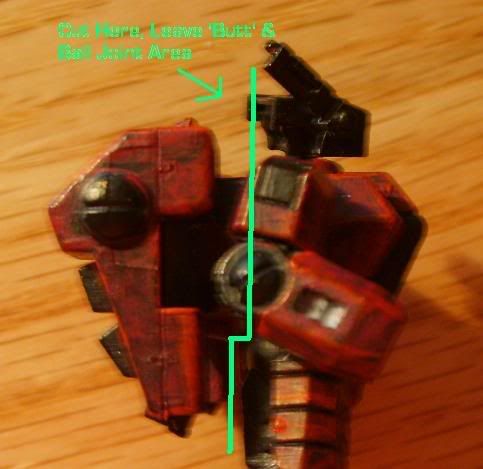
After that, you'll need to combine the two Jet areas into a single pack so it resembles a Stealth Suit jet pack.

This shouldn't be tough and can be done with only a minimal amount of confidence. Glue everything up and you have the Jet pack, that looks a bit like this. (Please note this isn't done yet. It looks pretty sloppy in the picture...)
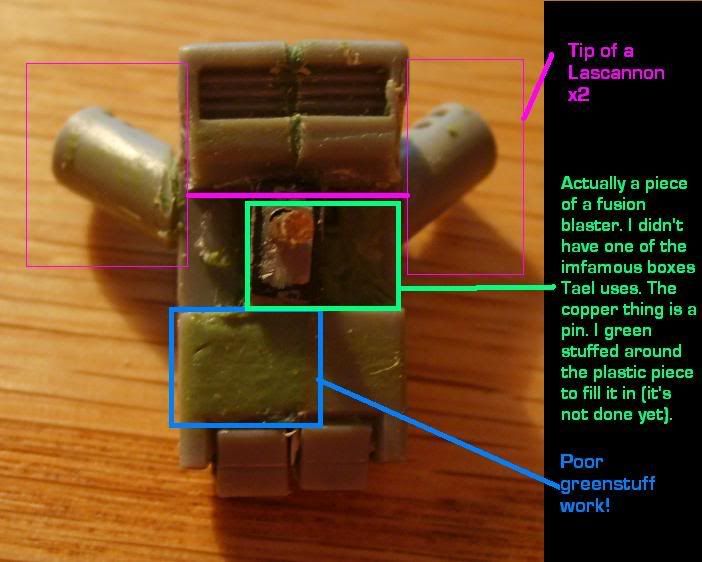
Unless you're a master cutter, some greenstuff work must be done on the vents.
OK, the fun part is the chest piece. It takes some subtle knife work but in general it's not too hard. I'm also gonna say right now, please be very careful when cutting. My fingers look like they got in a fight with the knife section in your local kitchen appliance store.
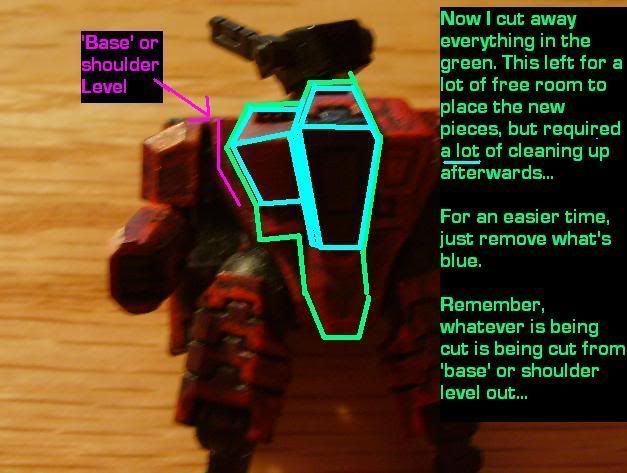
If you cut like I did it should look like this:
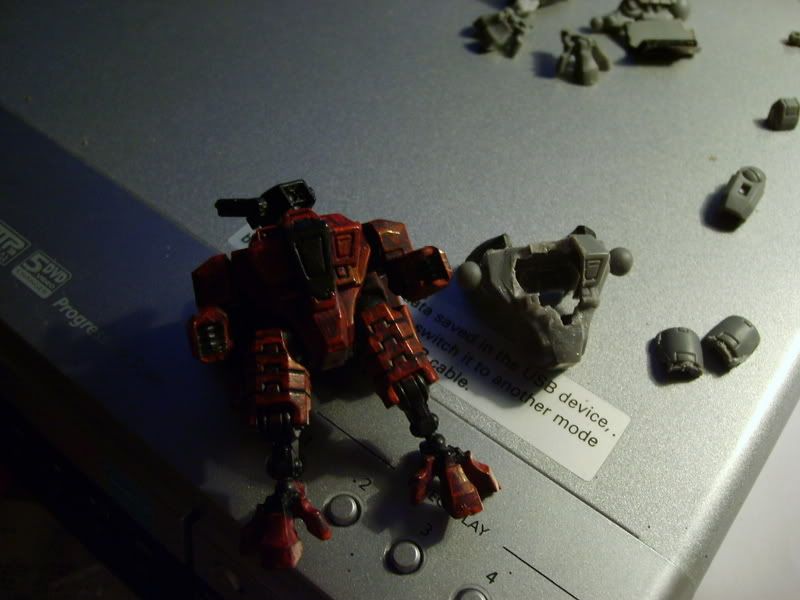
Pretty messy, it looks like a daemon prince had his way with it. Don't worry, to patch it up here are the pieces needed.
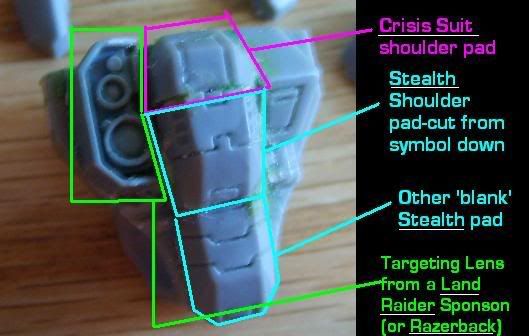
Just cut the items so they look like they are in the picture. If you cut like I did, you'll need to do some excessive greenstuff work.To prevent this specifically only cut out the center and the protruding upper breast plate. Filling gaps is one thing, but plugging holes is a pain.
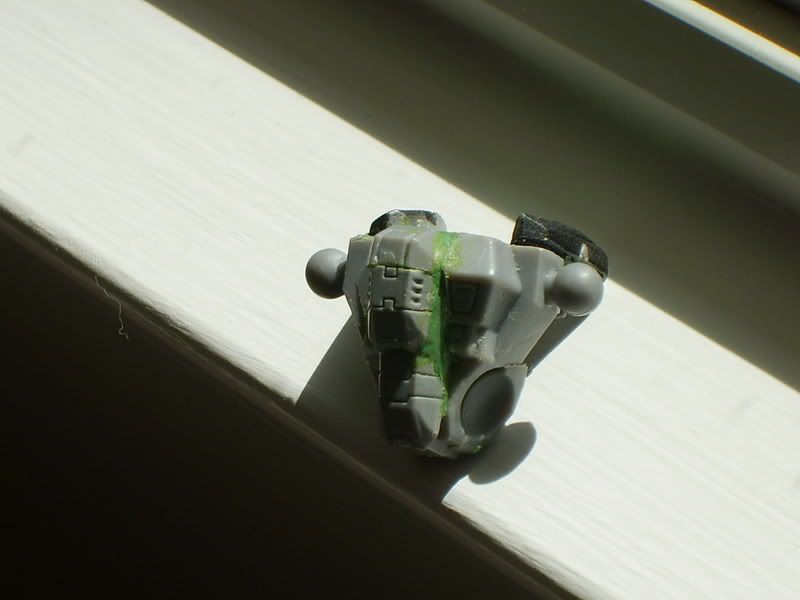
For the connection between the Jetpack you made above and the newly greenstuffed Torso:
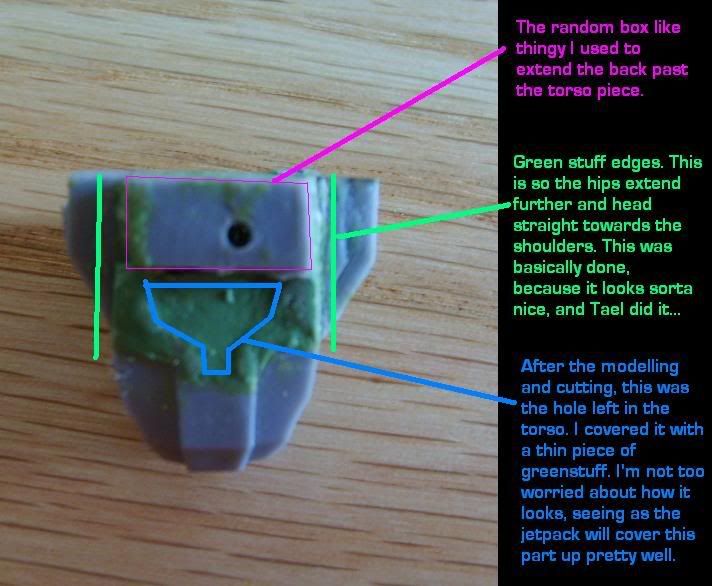
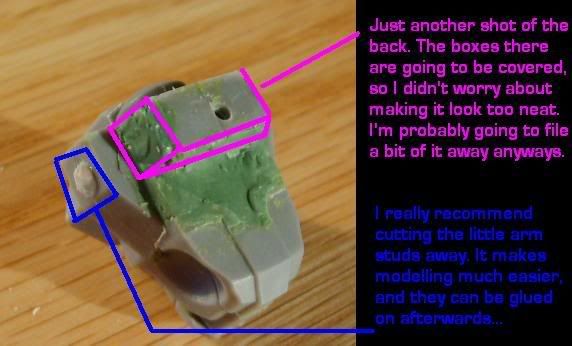
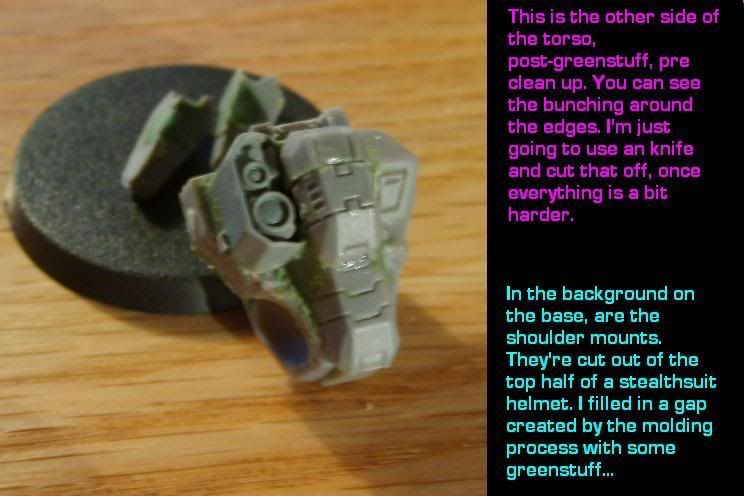
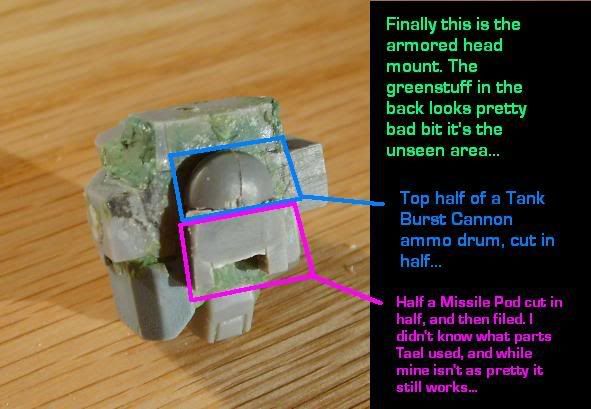
With the full Torso and Jetpack done connect them and then mount the shoulder pieces. Here's how my dude looked afterwards:
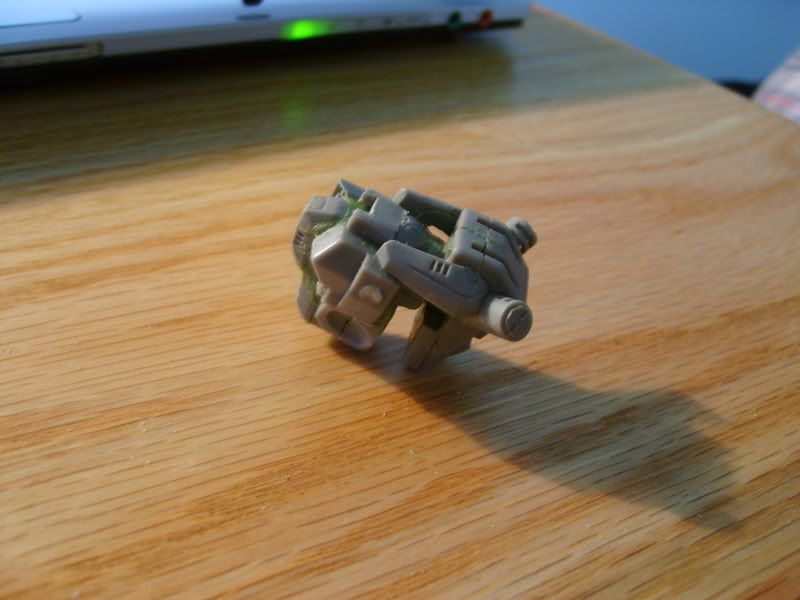

That was the hardest part. On to the legs! Start with good old standard Crisis legs (and pin them!). Grab that Land Raider sponson cover and two extra Crisis big toes.

Time to Build a head. The pieces are listed in the picture. Just shave or cut them down to fit and throw them on a regular crisis head.
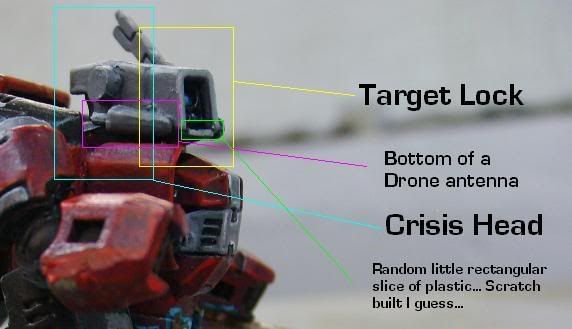
Here's what you should have when all the previously built pieces are combined!

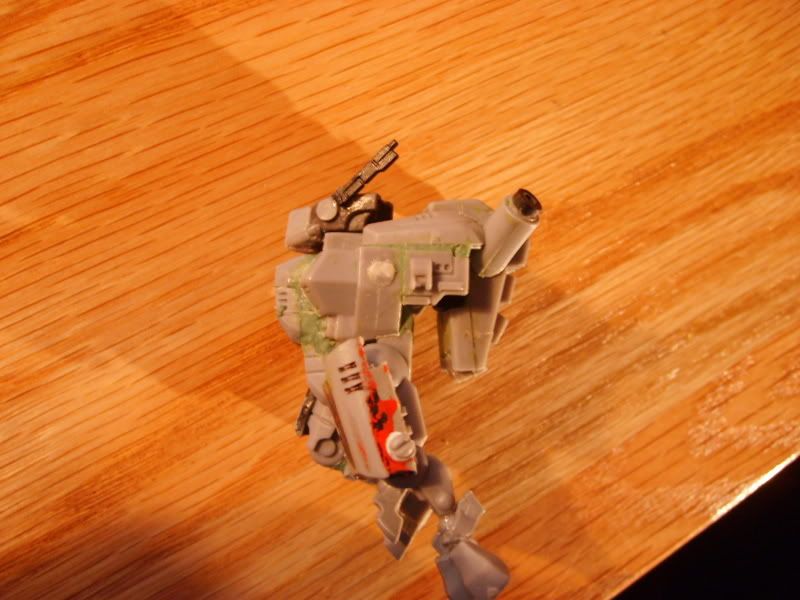
The arms are created as shown below. A burst cannon drum, a piece of a Space Marine jump pack, and a Crisis Suit arm are needed.
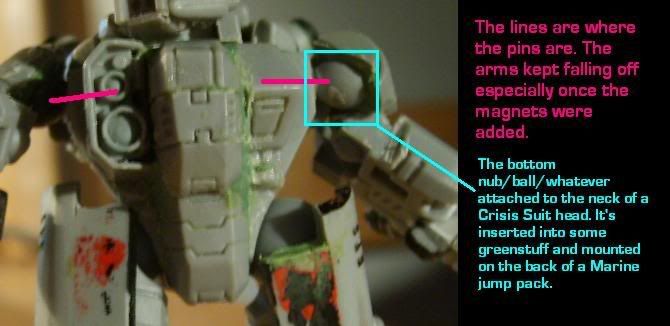

Finally when everything is combined you'll have this:
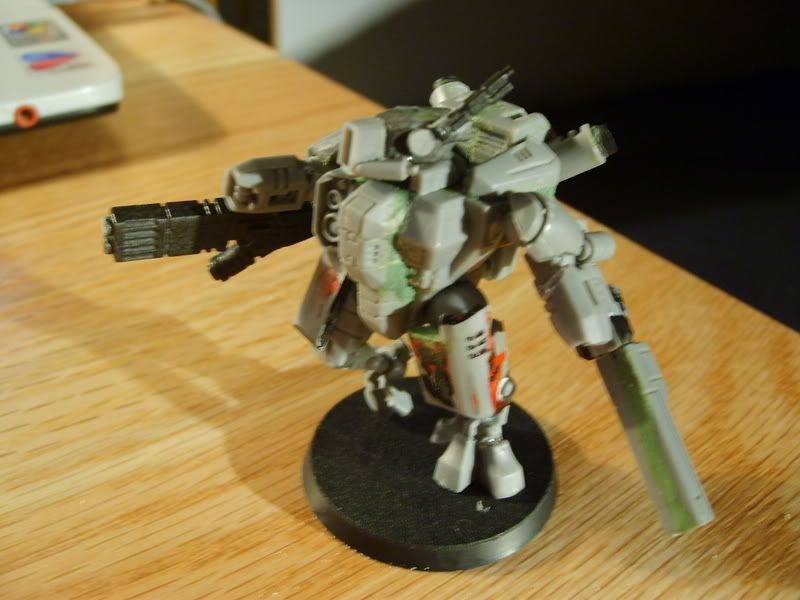
Congratulations! You should now be a paint job away from a great Tael style Tau Stealth Crisis Battlesuit!
Tournaments are generally a legitimate excuse to bring out an army’s big guns and play rough. There are enough postings on the web about how to create a cut-throat competitive army, and while these lists satisfy most tournament goers, they don’t satisfy me. I honestly can’t step back and look at 40k as purely a game, because doing that removes all the great fluff and atmosphere that the game was arguably intended to embody. So how can you compromise between 40ks fluff filled, gothic setting, and a tournaments spirit of competition?
First and foremost, before list building, realize that a tournament is essentially a chance to play three games against potentially new opponents. Whether you already have a gaming club or not, they present a great chance to meet new guys who can become members of the more often indulged in casual, beer and pretzels gaming scene. All standard sportsmanship rules apply, and remember, you don’t want to come off looking like a rules as written (RAW) fascist. Even in a competitive setting, give your opponent the benefit of the doubt concerning tough measurements or template contacts. Always allow dice to be re-rolled if there is ever a question from either side. Even more importantly remind opponents of decisions that make no sense on their part. For example being unaware of Dark Eldar Grotesque rules and shooting at them with Bolters (Only Strength 5 can hurt them!). Even in a tournament setting, not telling your opponent about those sorts of special rules is sneaky and a low blow. Friendly reminders and special rule heads ups can go a long way for both your sportsmanship and the overall atmosphere of a tournament.
Fluff is a double edged sword in tournaments. In can be used to present great, fun, flavorful lists, or it can be used to justify some of the worst spam out there. There’s no denying that a Pedro army shouldn’t have Sternguard units included, but having them jam packed to the brim is brutal to say the least. How do you make a flavorful list without abusing it? Take these following points in mind when constructing a list:
-Get a general theme. Tau Supply Line Disrupters (ala Taros), Eldar Court, Guard Artillery Company, Ork Freebootas, etc.
-Rationalize the conflict size to the points size. For instance a large Marine engagement (2500p+) might have you seeing more than one Landraider, and a Force Commander, and some other heavy stuff. A 1500p engagement might only have foot slogging troops and a lesser HQ with maybe only one or two tanks to back them up. Remember Land Raiders, Wraithlords, Elite command units, and equipment like Shokk Attakk Guns are rare in the 40k universe. Why and how would a commander be able to requisition many rare items for a small battle?
-View your squads as individuals, not as little gaming pieces. Marines for instance are unique and will have unique and varying equipment. Ork Meks rarely make the same thing twice (successfully). Multiple units with same builds can be effective but not all together realistic especially once army fluff has been introduced. Necron and some Guard regiments can be excused, but come on, transform your little men into toy soldiers, not chess pieces.
-Shy away from Internet and Math Lists. More of a general rule of thumb, make your list your own. It’s a little too easy and tempting to fish online for a great competitive list or a list where averages are always in your favor. I have a theory that deep down every 40k player is still a bit of a hobbyist and because of this, a personalized, unique list will always be more interesting than a copy-paste clone.
With these ideas in mind how do you still stay competitive? To be honest it’s not all that difficult. Skill and luck often have more effect on the game then units do. Build with an all comers mind set. With 5th edition vehicles are more beefy, but ways to hurt them are also more plentiful. Mix meltas and plasmas, take an autocannon or two. Have a clear and defined anti-tank ability for three or four of your units, but vary the design. Obliterators are the swiss army knives of tank killing, but Chaos marine squads can carry plasma and lascannons as well and they even count as scoring. Balance is sometimes a virtue. The ‘character’ specific fluff roles attributed to squads and individuals should help conceive and rationalize codex choices.
After you conceive your list put it to practice. Learn what a unit’s in-game strengths and weaknesses are, not their theory hammer expectations. Individuals with all their eccentricities have flaws and so do your units. With this knowledge you can play your army more effectively… you can play it competitively. Playing competitively doesn’t need to mean Winning At All Costs and building a list to do so easily, what it means is playing with knowledge and skill, and attempting to use strategic, well thought out maneuvers and tactics to pull off a win and more importantly a great game. Even a poor list when played well can do wonders, and in a tournament setting a poor list isn’t required… but a flavorful one is appreciated! Like with all things there is a golden mean, and in the grim darkness of the far future there doesn’t simply need to be just causal fluff games or deadly serious competitions.
Well after all that preaching I might as well give sample competitive Tau list built with fluff and a theme in mind:
HQ - Shas’El: Missile Pod, AFP, HW Multi-tracker , HW Target Lock, Stims, Bonding Knife, Positional Relay 122p
Elites – Squad (3) Crisis Suits: TL Missile Pod 159p
Troops – 10 Firewarriors: Carbines 215p
Devilfish:SMS, Disruption Pod, Flechette
Troops – 10 Firewarriors: Rifles 225p
Devilfish: SMS, Disruption Pod, Seeker Missile x2
Troops – 11 Firewarriors: Rifles, Shas’ui w/Markerlight 130p
Troops- 14 Kroot: Shaper, 10 Hounds 172p
Fast Attack – 5 Kroot Riders (IA3) 200p
Fast Attack – Tetras Squadron (2) – Targetting Array 110p
Fast Attack – 10 Pathfinders 225p
Devilfish: SMS, Disruption Pod
Heavy Support – Broadside: ‘vre, A.S.S., HW Drone Controller, Shield Drone (2), Bonding Knife 125p
Heavy Support – Broadside: ‘vre, Shield Gen, Plasma Rifles, HW Drone Controller, Shield Drone (2), Bonding Knife 145p
Heavy Support – Hammerhead: Railgun, Burst Cannons, Disruption Pod, Multi-tracker 165p
1999points KP- 15 Scoring– 4
 The army picture above is scaled down 1750p version of the list shown above (it is missing a Hammerhead and few bodies). The list finished in overall 8th out of 22, with two wins and one loss.
The army picture above is scaled down 1750p version of the list shown above (it is missing a Hammerhead and few bodies). The list finished in overall 8th out of 22, with two wins and one loss.
The theme is based on the average force that Imperial Scouts and supply lines would face during the Taros campaign. Tetras and Pathfinders would guide Orca inserted Broadsides toward valuable targets while Kroot harass the advancing scouts or rear guards. Once the enemy regroups the main Tau force would slide in to provide cover for a quick withdrawal and the whole force would disappear using its cloaking technology. In game you can use a firebase of Firewarriors and the stationary Broadside to harass the enemy while shielding the pathfinders who eliminate cover and boost BS for the army’s other units. The Kroot riders are counter charge units or can also used to single out smaller squads without Power Fists (they have three wounds a piece!) The Kroot either hunker down in cover, on an objective, or act as a tar pit (they can also flank!). The Crisis and HQ eliminate transports and target GEq squads, while the two devilfish teams can contest object late game (helped by the HQs positional Relay) or get in some cover and add to the weight of fire.
I can never pretend to think that I’ll sway everyone, and there will always be guys out there who do only look to win no matter what. I however don’t think tournaments should be their justification, or even a sore subject with beer and pretzel gamers. There is absolutely a realm where competition and 40k as a setting can meet, and I am of the opinion that it is one of the finest places the hobby and game can go.
Wherein our villains' campaign is interrupted,
Our Host receives an unwelcome visit from supposed allies,
And festering enmities flare into open hostilities.

“Released from our oversight, our minions grow confident,” Auguax began, shifting his massive bulk. “Indeed, under M’Bashaar’s generalship they become adventurous and aggressive.”
E’Aasu nodded neutrally, studying his fellow daemon lord. The Unclean One appeared uneasy. His countenance was placid enough, but his habitually inane grin was gone and the flies that circled the daemon, the maggots that crawled continuously in and out of the sores covering his piled masses of rotting flesh, all seemed agitated. “Just as we anticipated,” E’Aasu replied after a moment. “Indeed, just as we hoped. The Harrowed must be trained as an army, a purpose for which the Bloodthirster is eminently suited. And then, of course, in any event we agreed that stewardship of the Host would be rotated among us.”
“And yet I become concerned,” replied Auguax. “M’Bashaar’s power waxes. He has spawned legions of new bloodletters – daemon troops uncommonly fortified by the powerful biologies of possession you have devised. Fed by victories, his ambitions and appetites swell unchecked.”
E’Aasu clucked, affecting indifference. In truth, though, he was reaching the same conclusion. Like Auguax, he had sent a lieutenant, a daemon prince, to accompany the footsoldiers he covenanted to M’Bashaar’s forces. And the reports the Lord of Change had been fielding from his emissary A’Aglala confirmed the indications Auguax was obviously receiving from his own envoy. The Bloodthirster was growing audacious—a potentially dangerous development.
With an effort, E’Aasu suppressed a grimace of annoyance. It was always going to be a dangerous gambit. They had all understood that from the beginning. It was too late to pull back now. Nor did E’Aasu wish to. No, the Lord of Change had no desire to wind down this game yet. It was growing delightfully twisted. Intricate possibilities, obscure contingencies, innumerable permutations had been put in play here.
The Bloodthirster would have to be dealt with, though. E’Aasu stole another glance at Auguax. Interesting that it had been the Unclean One who had approached him. He had been expecting their sister sovereign, Ulular, the Keeper of Secrets. Evidently distrust had erupted between Auguax and M’Bashaar—perhaps between their patron gods. It might be useful to nurture such a development.
He smiled. “And just what do you propose we do about this little problem of ours?”
Sam is a Plaguemarine general who usually plays at a neighboring store, Pandemonium (in Cambridge, Massachusetts). And it must be said, he brings a very well-crafted Death Guard army to the table.

He and I had faced off a month or two ago, his Death Guard vs. my Daemons. That initial encounter had gone disastrously for the Plaguemarines. While Typhus and Terminators waited four turns in the Warp (holding 600 or 700 points off the table), my daemons ran roughshod over the battlefield, eviscerating everything they could find. The encounter was so one-sided I decided not to write up a battlereport. Sam, quite naturally, lobbied for a rematch. It took a few weeks, but eventually his Death Guard did track down my daemons to demand satisfaction.
This time we played at Danger Planet (my homeworld, in Waltham, Massachusetts). We rolled Capture and Control for a mission, and at Sam’s request adopted a Pitched Battle deployment.
We set the battle at 1750 points (at my request, as I was fine-tuning a list for a tournament next week.)
Sam mustered:
Typhus
7 Terminators, including lightning claws, reaper autocannon, power fists..
3 squads of Plaguemarines with suitable accoutrements (plasmaguns, powerfists, etc.)
A defiler
3 obliterators
A dreadnought with plasmacannon (which, incidentally, Sam had not planned to field, but which I urged him to include, on the basis that it was such a damn fine model!)
For my part I summoned:
M’Bashaar, the Bloodthirster
3 flamers
4 fiends
8 bloodletters
14 plaguebearers, with icon
7 plaguebearers
9 horrors, 1 with Bolt of Tzeentch
9 horrors, 1 with Bolt of Tzeentch
Authrax-Ogun, Soul Grinder with phlegm
A’Aglala, Daemon Prince, Mark of Tzeentch, Daemonic Gaze, Bolt of Tzeentch
Sulsk, Daemon Prince, Mark of Nurgle, Iron Hide, Noxious Touch, Cloud of Flies
The terrain consisted of urban ruins. Sam placed his objective on the second floor of a shattered building deep in his zone; I placed my own objective similarly, behind a building deep in my zone.
I won the dice-off to choose turn order, and chose to go second.
Turn 1, Death Guard
One of the Death Guard tactical squads dug into the ruins in which Sam had planted his objective, fortified nearby by the three obliterators. His defiler and dreadnought set up on one flank; one of his remaining two tactical squads set up on the other, and the third squad took position near the middle.
Despite our earlier experience, Sam elected to hold Typhus and his retinue in reserve. (This was probably wise, given the mission and his army’s relative lack of mobility.)
After the Death Guard finished deploying and moving, the field of battle looked like this:

Turn 1, Daemons
I was facing a durable and lethal opponent—but one with only three troops choices. I decided to focus my early efforts on taking out plaguemarines. The looming presence of Typhus and 7 terminators was certainly daunting, representing a formidable threat to my own objective. I’d just have to wait to see where and how Sam played it. For that reason, I decided to try to keep my Khornate shock units in reserve. For my first wave, I chose: the two Daemon Princes; the Soul Grinder; the large pack of Plaguebearers; the Flamers; and the Fiends
The battle began inauspiciously when A’Aglala, the Tzeentch Prince, scattered badly and tried to materialize amid Death Guard. Rolling on the mishap table, I produced a 1, indicating the half-breed had been lost in the Warp.
Muttering dark incantations to the Ruinous Powers beseeching better favor for my deserving servants, I landed the rest of my first wave more-or-less successfully. The Flamers appeared beside a squad of Death Guard, which it promptly wiped with a withering volley of Breaths of Chaos. (That’s one of Sam’s three troops choices taken care of.)

The Soul Grinder proved less efficacious, however. Though it landed successfully, its efforts to target another Death Guard squad with a blast of phlegm scattered off-target.
Other units scurried and scattered as they took material form, adjusting positions in a series of “run” moves. The large plaguebearer pack in the middle of the table, represented the nucleus of my plans to coordinate an assault on Sam’s objective, dispersed with particular urgency, anticipating heavy incoming fire.

Here’s how the battle looked at from a bird-eye perspective this point:

Turn 2, Death Guard
A successful reserve roll summoned Typhus and retinue promptly—but evidently inaccurately: a bold attempt to land the Host of the Destroyer Hive right in the midst of my advancing forces produced a mishap roll. Fortunately for Sam, he rolled a favorable result: delayed. (That suited me. Early arrival would have seriously blunted my advance on Sam’s objective. Utter destruction would have crippled his army and gutted the game.)
One Death Guard squad mowed down my flamers, engulfing them in sheets of rapid-firing plasma and boltershells. (One plasmagunner did perish in the firestorm, however, when his plasmagun overheated.)
The obliterators leveled las-cannons on my Soul Grinder, hitting it only once, with a glancing hit that tried to stun the vehicle. (The daemon inside the construct laughed balefully.)
Sam concentrated most of the rest of his firepower on the large pack of Plaguebearers approaching his objective. A solid hit from the Defiler’s battle cannon smeared 3 into puddles of ichor. Concentrated rapidfire rounds from the other Death Guard squad sent another 3 of the daemons back to the Warp. Plasmacannon bursts from the Dreadnought destroyed several more. My advance guard of daemon troops, as tough as it was, had been severely whittled down.
Turn 2, Daemons
The second Plaguebearer pack and both Horror packs reached the battlefield (leaving the Bloodthirster and Bloodletters back on the other side, slashing in frenzied rage at the Warp barriers). I used the icon to guide in one of the Horror packs and the newly-arriving Plaguebearers alongside my large (though diminished) Plaguebearer advance guard, bolstering the forces threatening Sam’s objective. The other Horror pack materialized farther back toward my objective.
My Soul Grinder turned and targeted the Death Guard’s Defiler with a blast of phlegm – ineffectually.
The Horrors’ warpfire poured in on one of the Death Guard squads, though the hardened traitor marines shrugged off the incoming fire.
My fiends I sent back into the cover of nearby ruins, positioned either to lend support to my assault on Sam’s objective, or to help defend mine, depending on when and where Typhus and company appeared.
An effort to send the (surviving) Plaguebearers from the large pack charging into the closest Plaguemarines failed when the daemons rolled double 2’s (more slow than purposeful). The Nurgle Prince needed no such impetus, however, and charged in itself, undaunted. He destroyed two cult marines, but took a pair of wounds himself from the champion’s powerfist.
Turn 3, Death Guard
Trying again to join the battle, Typhus and his retinue this time bursting through safely, close to Horrors and Plaguebearers. The ancient traitor marine commander and his Terminator honor guard targeted the Horrors, wiping them out with heavy flamers, Typhus’s bilious discharge, and storm bolters.

The obliterators again targeted my Soul Grinder, again glanced the thing, again “stunned” it, again elicited only mocking laughter from the daemon inhabiting the unholy engine.

The unengaged Plaguemarines continued to pour fire into Plaguebearers, disintegrating several more in mists of ichor and pus.
In the combat phase, my Nurgle Prince wiped out the Plaguemarines surrounding him.
Turn 3, Daemons
Both M’Bashaar the Bloodthirster and his favored Bloodletter troops clawed their way through the Warp, onto the battlefield. Now that Typhus and his retinue had appeared, my opponent’s dispositions were set. I using the icon to summon the greater daemon and his shock troops in near the center of the action—in position to counter the terminators and in a part of the field, I hoped, where Sam’s forces would have too much to worry about to concentrate much firepower on the new arrivals. To buttress this move, I moved the Fiends from hiding, to lend support.
In the battle of daemon engines, my Soul Grinder destroyed Sam’s defiler with a penetrating blast of daemonic phlegm.
The second Horror pack, meanwhile, scrambled into ruins back toward my objective, hurling warpfire (ineffectually) at the Terminators as they retreated.
The Fiends and Nurgle Prince then charged into Typhus and his honor guard. The daemons killed 2 Terminators and wounded Typhus. In return, the Nurgle marines wounded one of the Fiends and destroyed the Nurgle Prince.
One of my (dwindling) Plaguebearer packs, meanwhile, charged into the obliterators. (I didn’t expect to win this combat, but I hoped to keep the obliterators from firing, buying time for my remaining plaguebearers, who circled the ruins, trying to get at the Death Guard holding the objective.)

Turn 4, Death Guard
Sam’s Dreadnought went into blood frenzy and hurtled into the Bloodletters, initiating a combat that lasted several rounds and ended, inevitably (since the daemons were not strong enough to pierce the walker’s heavy armor plates) with the destruction of the Khornate troops.
In the combat between Typhus/Terminators and the Fiends, meanwhile, the Plaguemarines’ greater durability began to wear down the daemon beasts.

Endgame
By this point, I had a handful of plaguebearers approaching Sam’s objective – hardly an imposing advance wave, but one backed up by a Bloodthirster. My own objective, meanwhile, was secure: Horrors surrounded it, and Sam had been forced to commit everything in his army to defending his own position. Once that first squad of Plaguemarines had gone down, Sam had been playing to contest rather than claim my objective. Typhus’s Terminators had represented his best hope at accomplishing that. By throwing my Nurgle Prince and Fiends at them, however, I had managed to mire them in combat for a crucial several rounds., and though they were about to emerge from that combat largely intact (with, IIRC, 4 terminators and Typhus himself), they were still a good distance from the objective. Looking things over, Sam decided he had to commit them to defending his objective, if possible. Now he was playing for a draw.
In the event, however, the Terminators and the Dreadnought (which required several rounds of combat to dispatch the Bloodletters) were too far from Sam’s objective to lend assistance there until it was too late. On Turn 5 the Bloodthirster landed in the ruins containing Sam’s objective, assaulting the surviving Death Guard tactical squad, while 4 Plaguebearers managed to stagger their way in on the other side, joining the melee.

One turn later, the Obliterators, having dispatched the Plaguebearers they were fighting, turned to tackle the Bloodthirster. Even this last ditch effort failed to bolster Sam’s desperate defense. On the bottom of Turn 6, the Thirster wiped out the last of the cult marines. The game ended, leaving me in possession of my objective (with that Horror pack), and Sam with no troops to hold his own objective.

Victory to The Harrowed.
Debriefing
My army matches up pretty well with this kind of opponent. A Death Guard army is tough and, at close range, lethal – but doesn’t muster a lot of bodies and it’s slow, more or less forcing Sam to make certain kinds of dispositions. It’s also distinctly vulnerable to the kinds of threats my army brings to bear. Generally speaking, cult marine armies sacrifice numbers to field troop units that are more elite. A Death Guard army, for example, in effect spends a lot of points for T5 models. But my flamers, bloodletters, bloodthirster, daemon princes, soul grinder, and plaguebearers all do fine against T5. With just a bit of luck (my preferred wave coming in first; Typhus and the Terminators holding off for just a turn or two), I should be able seize the initiative more often than not. That’s what happened here. Sam felt compelled to spend most of his energy trying to blunt my move on his objective. I held my initiative with minimal assets, and (for the most part) managed to bog down the Death Guard’s most dangerous units.
So much hinged on the timing of summoning and deepstriking. Typhus and the Terminators held off just long enough for me to fill the middle of the field with troops; then M’Bashaar became available immediately afterward, when Sam was flooded with threats and unable to give the greater daemon the attention he knew it deserved.
Things might have gone differently. Sam usually fields a squad of bikers. He altered his list to include the dreadnought after I admired it. Perhaps that made a difference. If he had been able to send bikes around a flank, and support them with deepstriking Typhus and Terminators, I would not have been able to take my own objective for granted. The threat of that scenario might have forced me to hold more of my forces off of the assault on Sam’s objective.
In helpless rage the Host of the Destroyer Hive gathered his surviving forces and pressed through the ruins. Ahead, in the shattered shell of an imperial cathedral, he sensed the last of his plaguemarines falling. Then a roar of triumph rose from the ruins, and Typhus knew he was too late. The Bloodthirster had found the prize.
For a moment Typhus was tempted, sorely tempted, to press on into the ruins, to bring the daemon and his lackeys to account. A good number of the terminator honor guard remained able to fight, and the ancient Dreadnought Obloloq had emerged from his butchery of the bloodletters scratched, nicked but intact. His army still had plenty of bite left in it.
With an effort, though, Typhus calmed himself. This situation bore further examining. This was no ordinary daemon host. Somehow the Bloodthirster had gained control over new and potent vessels of manifestation. Especially troublingly, it had drawn into its ranks daemonic entities over which the Destroyer Hive should have commanded suzerainty—daemons from the bosom of Nurgle himself. Plaguebearers had drawn their blades against the Death Guard. So too, if Typhus were not mistaken, had a daemon prince marked by Nurgle.
No, better to withdraw. Nurgle himself would want to be appraised of these developments. Deep schisms were at work here.
“Make ready to return to the Terminus Est,” he growled.
“But Lord, the enemy—“
“Have already shattered our contagion nursery,” replied Typhus grimly. “Do not fret, brother. There will be a reckoning. By Grandfather Nurgle himself, I swear it.”

































